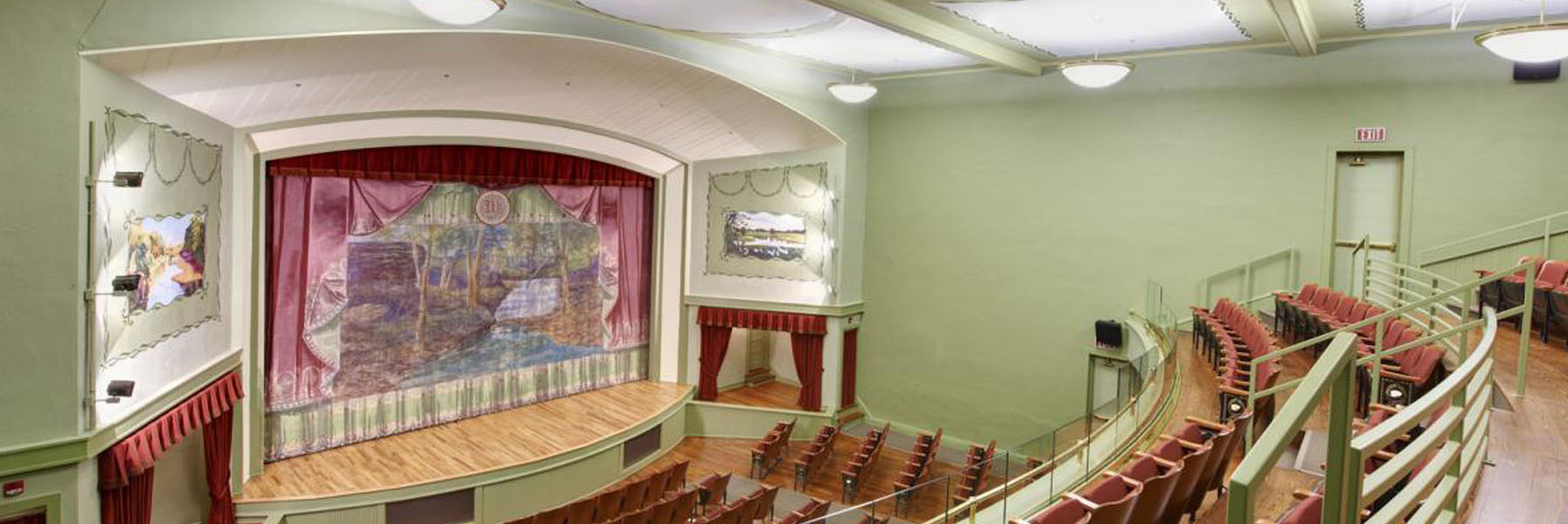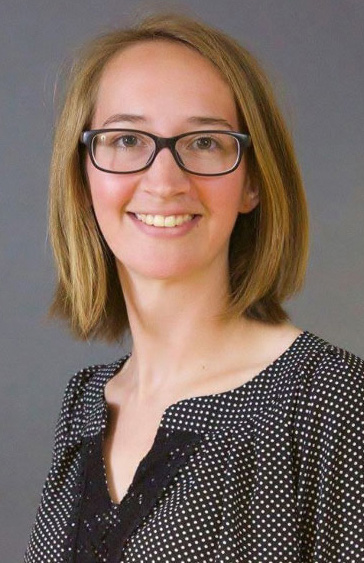Toledo, Iowa’s Wieting Theatre Opera House opened for the first time in September of 1912. It measured just 50 by 100 feet and had elaborate murals on the walls to the left and right of the grand stage. The stage was masked by a hand-painted tapestry that hung down and brushed the wood floor beneath it. The building itself has seen many changes during the century since its opening, but throughout its history it has provided Toledo with a warm environment where the community has been able to experience the arts and enjoy time spent with one another.
History
The Wieting was named for the family of Dr. P. G. Wieting and his wife, Helen, who moved to Toledo, Iowa, in 1867 from Worchester, New York. Dr. Wieting was a practicing dentist and later a successful bank owner with his father-in-law, N. H. Wilder. They opened the bank together and called it the Toledo City Bank.
Later the Wietings would move back to New York, this time to Syracuse, where they once again found success. The Wietings never forgot Toledo, though, and later, after Dr. Wieting passed away, Helen decided to honor her late husband by donating money from his estate for a good cause. Helen bequeathed money to build a theatre in each of the three towns where they had resided, one theatre in Worchester, New York, one in Syracuse, and one in Toledo. The theatres were dedicated to the memory of Dr. Wieting and also served to celebrate Mrs. Wieting’s passion for the arts.
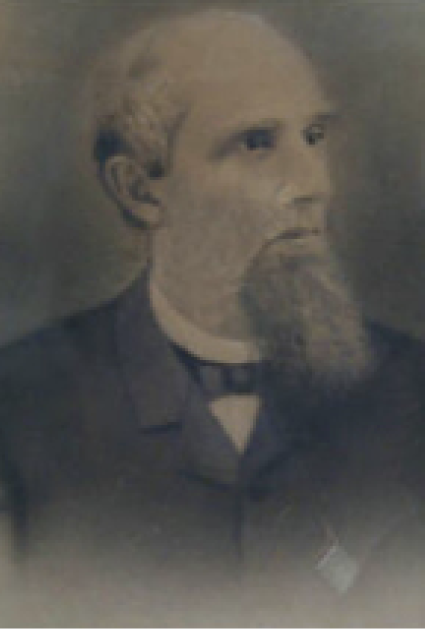
Photo of P. G. Wieting, DDS, courtesy of Abigail Evans
After Helen Wieting made a $20,000 donation from her husband’s estate, construction of the Wieting Theatre began swiftly. The project was started in March of 1912 and completed by September of that same year. The Wieting Theatre Opera House was ready to open its doors.
In its original grandeur, the theatre contained 650 seats and was equipped with a stage, an orchestra pit, a box office, bathrooms, a balcony, and dressing rooms. The building had a red brick exterior, with stately, white pillars framing the front door.
Although the Wieting Theatre began as an opera house, it was host to various events since its inception. The opening night event was Verdi’s “II Trovatore.” Joseph Sheehan was a famous tenor at the time and the star of the show. At that time the venue was used to host traveling shows and musicians, graduations, high school and college plays and productions, political conventions, and minstrel shows. The Wieting has always been a resource to everyone in the community—even for those that its supporters disagree with. As noted in the history hall, there was once a Ku Klux Klan gathering held at the theatre, an occurrence that is an outlier from the otherwise inclusive community that the theatre now condones. And within a year of the doors opening, the Wieting began to show films. The films were silent, and local talents were hired to accompany the films on piano. Twenty years later, the silent films turned into “talking picture” shows.

Early photo of Wieting Theatre Opera House, courtesy of Abigail Evans
By the late 1950’s, the Wieting began to experience competition for film showings from the opening of other movie houses in the Toledo area. Additionally, the rise of television drove down demand for theatre movie showings. Eventually the Wieting was barely staying open, running only on a part-time schedule until the fall of 1958, when the theatre’s management decided that it was no longer feasible to keep the Wieting operating, and it was shut down. A layer of dust formed over the seats, the stage curtains stayed in place, and the doors remained locked.
Resurrected by volunteers
The Wieting’s closure left a hole in the community. No other venue was home to the arts like the Wieting had been for 56 years. After a year and half, though, community members began to gather and talk about the possibility of reopening the theatre. A group of women gathered to discuss its importance in the community and, shortly after, convened to seriously evaluate the building’s fate. That day in April of 1960, 40 people gathered to create a vision for the future of the theatre. That became the first of many recurring meetings that still happen today. These community members turned into a guild of regular volunteers for the theatre and, a month after their first meeting, they wrote a constitution to guide their efforts, and immediately set to work to restore and reopen the Wieting Theatre.
The volunteers did not waste time, spending the whole summer working to learn the ins and outs of running the theatre as a business. If they were going to reopen the Wieting successfully, they reasoned, they wanted to know how to keep it in operation long-term. An executive committee was set up to spearhead the reopening, consisting of members Leo Benda, Dallas Sloan, Mrs. Willard Beadle, Mrs. Virgil Wulff, and Mrs. Charles Maplethorpe Jr. These five guild executives were active members of the community. For example, Leo Benda worked as a manager at the local post office and later became a Tama County Supervisor and Helen Beadle owned her own fabric store in Toledo called “Sunrise Sotique.”
To prepare for the reopening, these executive members, as well as other guild volunteers, spent many hours restoring the theatre. Volunteers painted the lobby, the front doors and the pillars that framed them. They installed a new movie screen, box office, and carpeting. In addition to overseeing this work, the guild also took in monetary donations. One business bought $60 worth of tickets which, at that time, covered the cost of 200 children’s tickets to see a show.
When reopening day came on September 16th of 1960, the Wieting was filled to capacity. That night two movies were shown, “The Boy and the Pirates” and Disney’s “White Wilderness.” The Wieting began selling family season tickets. Each of the five executive members bought season tickets, and their combined purchase totaled $100. Soon, 100 more family season tickets were sold, bringing in money to help the theatre get back on its feet. In attendance at the reopening event were Dr. and Mrs. Knight Fee, who also attended the original opening in 1912. While there were some community members who were able to experience both of these opening events, others experienced the Wieting for the first time that night. This success story could never have come to be without the countless volunteer efforts and the drive to keep the Wieting a home to the arts in the Tama-Toledo community. The volunteers were vital to the theatre’s reopening in 1960, and still continue to be essential to the Wieting’s success.
Today, the theatre stays open thanks to nearly 150 community members who regularly volunteer their time for the Wieting. The volunteers attend meetings, run concessions, collect tickets, greet guests and work behind-the-scenes to keep the theatre operating smoothly. The current support staff, consisting of the guild President and a few dedicated members who oversee daily operations, volunteer a combined 25-40 hours per week for the theatre.
It should be no surprise to learn that many of today’s guild of Wieting Theatre volunteers are highly involved in many aspects of the community. Denise Fletcher, a dedicated volunteer and the current guild President, is a retired fourth-grade teacher who is highly regarded in the South Tama school district. About her volunteer work, Fletcher says, “Life can be broken down into three stages. As a child you receive the benefit of other people’s experience and wisdom. In the second stage you begin to give to your family and career. Now as a retiree I feel I have the privilege to give back to my community. I choose to spend my time serving on the Wieting Theatre Guild. I feel that I continue to grow as a person by learning new things, meeting new people and striving to meet the needs of our community.”
The commitment demonstrated by volunteers like Fletcher would be necessary again in the early 2000s, when the Wieting faced challenges similar to those it faced in 1958. With movie rentals on the rise, families were opting to stay at home to watch movies rather than attending showings at the theatre. Additionally, many of the theatre seats were broken and the film equipment would often break down during movie showings. Volunteer projectionists would scamper to try to splice the films quickly to get them running again before guests would leave. It was very challenging to keep the theatre in the black during this time, and some of the guild members even paid the Wieting’s bills with their own money. Despite these hardships, the volunteers were determined to keep the theatre open and were hopeful that the community would support their efforts.
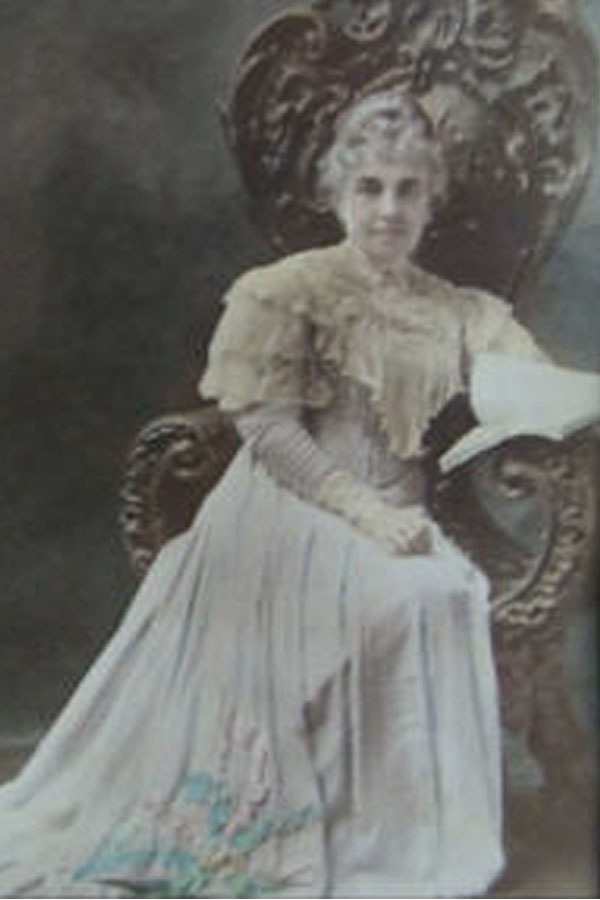
Photo of Helen Wieting, courtesy of Abigail Evans
Renovations
Once again, a group of guild members got together and started planning the salvation of Toledo’s cherished community resource. The volunteers imagined a renovated theatre with new seats and better lighting. The community ultimately supported the decision to fund this $1.4 million-dollar renovation project.
In addition to holding special fundraising events —including raffles, trivia nights, and themed dinners —businesses and residents were solicited for cash donations. Grant applications were submitted and awarded by Vision Iowa, Iowa Great Places, and the Mansfield Foundation, to name a few.
The plans for the first renovation included air conditioning, a new ticket office, new seats, digital movie equipment and surround sound, and a new addition to the theatre which would include handicapped-accessible restrooms, a family restroom, and a “history hall.” The history hall contains historical information about the theatre, lists of donor’s names, and many pictures of past events. This hall is an important timeline for the theatre and also serves as a way to thank the community and show appreciation for the Wieting’s generous donors. A sponsorship program was put in place to help reduce the overall costs of renovations. Donors were able to sponsor individual theatre seats, or more than one if they were inclined, for the price of $375 per seat. After they did so, their names were placed on a plaque that honored all of the donors, and was placed in the history hall. After volunteers worked tirelessly to plan and host fundraising events, and with overwhelming help from grants and donations, the Wieting reached its fundraising goals. The theatre was shut down for a year in 2011 to complete the renovations. Beside the new additions to the theatre, the murals on either side of the stage were restored. The original hand-painted tapestry, which had hung over the stage since the Wieting opened, was kept in place. The Wieting’s reopening was a marvelous success, with the average attendance for events more than doubling over the following year. Before renovations, average attendance had been in the low 20s. After, the average climbed to 56 people per night. The average income two years after the reopening was triple what it had been before the renovations. The theatre continued to be a place where community members could gather to watch movies and enjoy events. Even after these extensive renovations, the volunteer-run aspect of the theatre currently allows it to show movies for $3 for 2-D movies and $4 for movies shown in 3-D, with recent releases playing every weekend, Friday through Sunday and Thursday through Sunday in the summer months.
Looking ahead, the volunteers are now focused on planning and fundraising for a second phase of renovations to the theatre. The upcoming phase will focus on improvements to the theatre which are more behind-the-scenes than the previous renovations were. The goal of this phase is to restore live theatre performances to the Wieting’s stage. One of the main facets of the renovation is installing completely new lighting and rigging to make the space better equipped to host theatre performances. To complete these lighting renovations, improvements to the Wieting’s roof structure will be necessary. Improvements to the basement are also planned, to repair existing water damage.
The renovation also calls for upgrades to the backstage areas including the green room, restrooms, and make-up and storage areas. Additions for these areas will be built on the south side of the theatre and will be one story tall, making them handicapped accessible. The addition will also have space for a workshop for building sets and for a dining and event space that will seat up to 80 people.
The community will once again be crucial to the success of this project. Past and present community members have made contributions to the Wieting, ranging from people who are behind-the-scenes to a famous actor who grew up in the community. Michael Emerson, renowned for his role as Benjamin Linus in the American drama series “Lost,” graduated from South Tama and performed at the Wieting during high school. He has supported both phases of renovations by writing letters of support as well as making financial contributions.
In 2010, before the first phase of renovations were underway, Emerson made a visit to the theatre. An article titled “Michael Emerson at the Wieting,” published in the Toledo Chronicle, quotes Emerson the night he visited. Emerson stated, “We need to go that extra step to save this old-time theatre. A lot of us have histories here.” The article also mentions teachers who were particularly influential for Emerson during high school, including a community member and former teacher who is still helping the theatre today.
Anne Michael was Emerson’s English teacher and also directed high school plays during her career at South Tama. For a recent fundraiser Michael co-wrote a reader’s theatre piece with another former English teacher, Mary Fasse-Shaw. The humorous performance of this murder mystery piece titled “Mysterious, Gruesome, Yet Morbidly Fascinating Murder at the Wieting,” filled the house. The audience roared with laughter throughout the performance. The fundraiser was co-hosted with another local group, the Kiwanis Club. The event itself was free to attend, but free-will donations totaled over $2,200, bringing in about $1,100 for each organization, with the Wieting’s portion going towards the second phase of renovations.
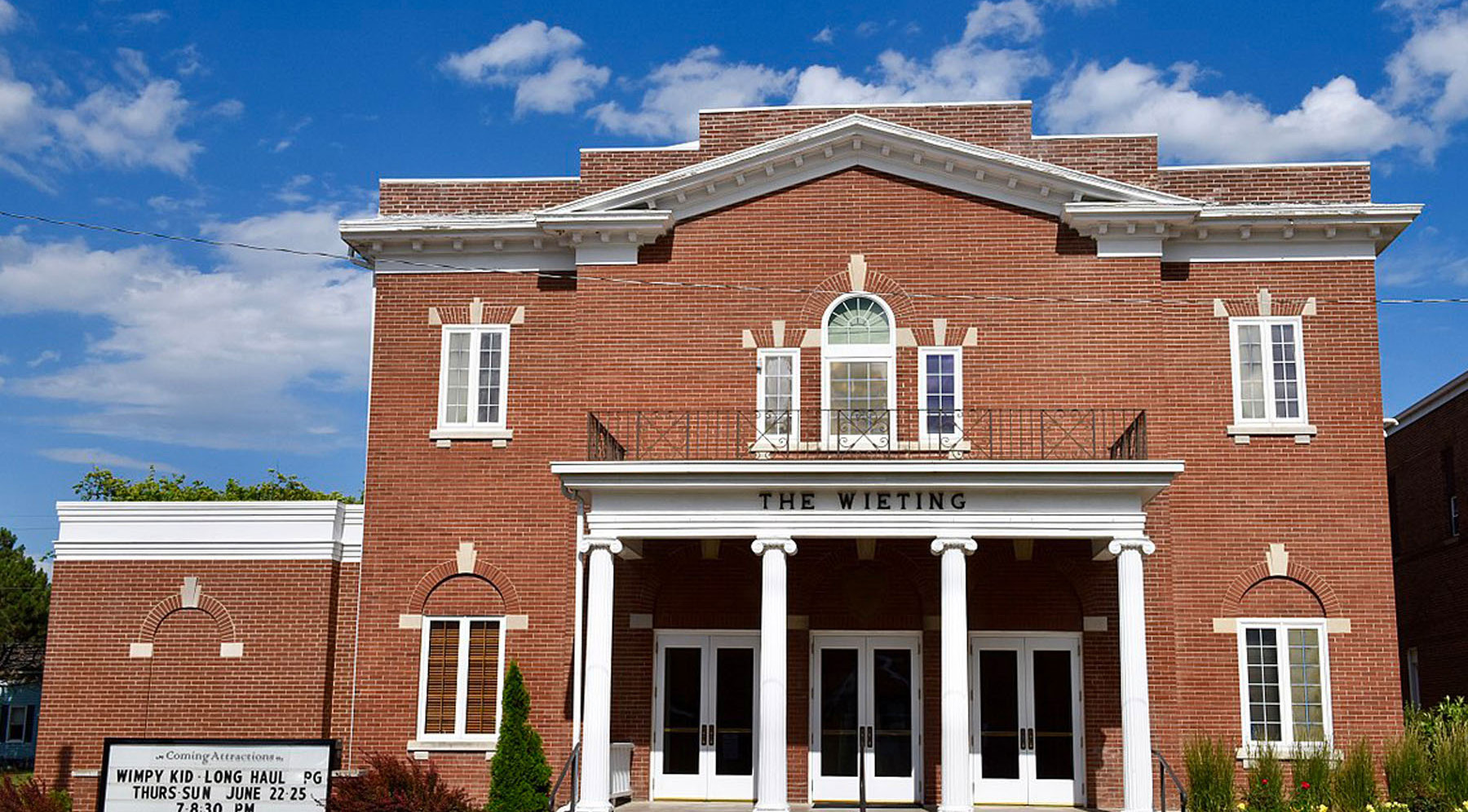
The Wieting Theatre Opera House after Phase I of renovation. Photo courtesy of Abigail Evans
For the first phase of renovations, donors were able to sponsor individual theatre seats. For the upcoming phase, a similar sponsorship will be available, but this time with stage lighting fixtures. Each light fixture costs $425. The sponsors will once again help reduce the overall cost of this new phase of renovations and they will be honored with their name on a plaque. If the theatre reaches its fundraising goals, it is likely that the second phase of renovations could begin as early as February 2018.
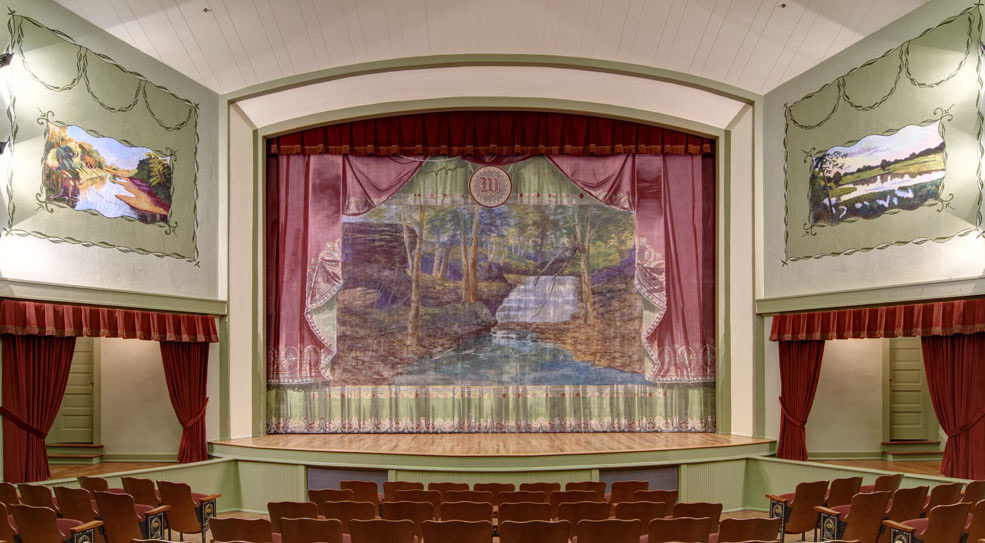
The interior of the Wieting Theatre Opera House, post-renovation. Photo courtesy of Abigail Evans
Community Life
The completion of the first phase of renovations brought with it a new wave of activity, sparking many new traditions at the theatre. Camp Creamery and the Fine Arts Performance Series are two wonderful examples of this activity.
Camp Creamery is a theatre camp that has been put on by the Wieting every summer since 2013. It is a week-long camp featuring actors from the Old Creamery Theatre Company, a not-for-profit professional theatre troupe founded in 1971 in Garrison, Iowa. Usually three actors from the troupe come to teach about 60 elementary and middle school students.
When camp is in session, kids come to the Wieting every day to learn a musical, which they then perform for the community at week’s end. Parents and community members alike are more than happy to buy tickets to see the musical put on at the end of camp, and so the event also serves as a fundraising opportunity.
Many of the same students return for the program year after year. It is a wonderful way to get young students involved with the Wieting and with the art of theatre.
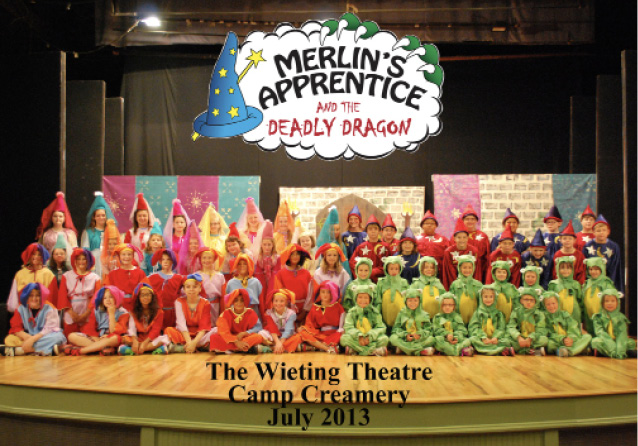
Young Thespians, trained at Camp Creamery, assembled on the Wieting’s stage. Photo courtesy of Abigail Evans
The Fine Arts Performance Series is another new Wieting tradition. The series, which started in 2014, honors all types of performing artists that travel to the community from one of the public universities in Iowa. Each season is comprised of four or five different shows, and in the past performers from both the University of Iowa and the University of Northern Iowa have gladly shared their talents with the community. The Fine Arts Performance Series has hosted musicians, dancers, singers, and musical theatre. Not only does the series create connections within the community and the state, but it also inspires high school students who are interested in pursuing the arts as part of their post-secondary education.
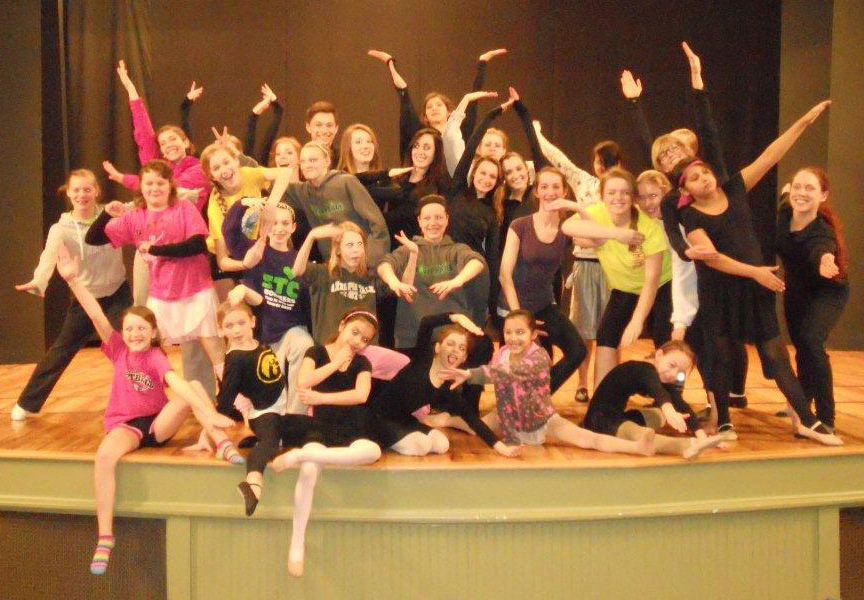
Performers from a master class in dance, hosted at the Wieting. Photo courtesy of Abigail Evans
I hold my memories of dancing at the Wieting close to my heart. I have many fond recollections of both performing and being an audience member at the theatre. From kindergarten through my senior year of high school I took dance lessons at the community center next door to the theatre. Up until the Wieting was shut down for the first phase of renovations in 2011, our yearly dance recitals were held at the Wieting. During my middle and elementary school years, my classmates and I would get changed into our costumes, slip on our ballet shoes and tiptoe to a small side door of the theatre that led directly backstage. We would huddle close together, waiting. I was always filled with such unequivocal excitement, sometimes peeking out from the sides of the stage to search for familiar faces. I remember watching the older girls dance their routine before we were able to take our places on center stage.
In 2014 a group of dancers, called Dancers in Company, came from the University of Iowa to perform at the Wieting for the Fine Arts Performance Series. The theatre decided to host a master class ahead of their performance to teach a dance to interested students. I signed up and attended the master class, which took place during March of my junior year of high school. We learned “modern” dance, which was quite different in style from the ballet moves to which I was accustomed. I was amused that we were directed to keep our feet flat and told that our arms could form any shape we desired; we were not restricted to rounded arms and pointed feet. It was an entirely new dance experience for me. This class gave me the courage to enroll in a modern dance course during my second semester at the University of Iowa.
Because our high school lacked a full-size auditorium, the Wieting was always a place for my classmates and me to pursue the arts. The Wieting is central to the community’s expression of the full range of its cultural life. Our local schools bring the students to the theatre for movie viewings that are often educational or relevant to topics which they are learning in class.
Additionally, the high school often holds events at the Wieting at which students are congratulated on their achievements, including the induction ceremony for the National Honor Society and the Senior Honors Exhibition – a town tradition which honors seniors who excel in the arts, whether that is theatre, vocal or instrumental music, dance, photography, or other forms of visual expression.
During my senior year of high school, I was able to perform a piece that I had written for a speech competition at the Senior Honors Exhibition. I stood alone on the stage, looking out at the same community members, students, and friends whose support had given me the opportunity to be standing where I was.
My senior year of high school I also used the Wieting’s stage to choreograph and rehearse a solo dance piece. I remember being all alone in the building, surrounded by silence and empty chairs. I felt as though those grand walls were reaching up with me as I began to move and turn to my song. My movements were slow and deliberate, the stage was smooth and cold. I leapt and I breathed and I spun and at the end of the song, I took a bow. That was the last time I danced on that beautiful, timeless stage.
The Wieting’s stage is made for dancing, but it is also made for theatre performances, for singing, for live music, and for celebrations of every kind. It has been serving the community for 105 years as a welcoming place for artistic expression.
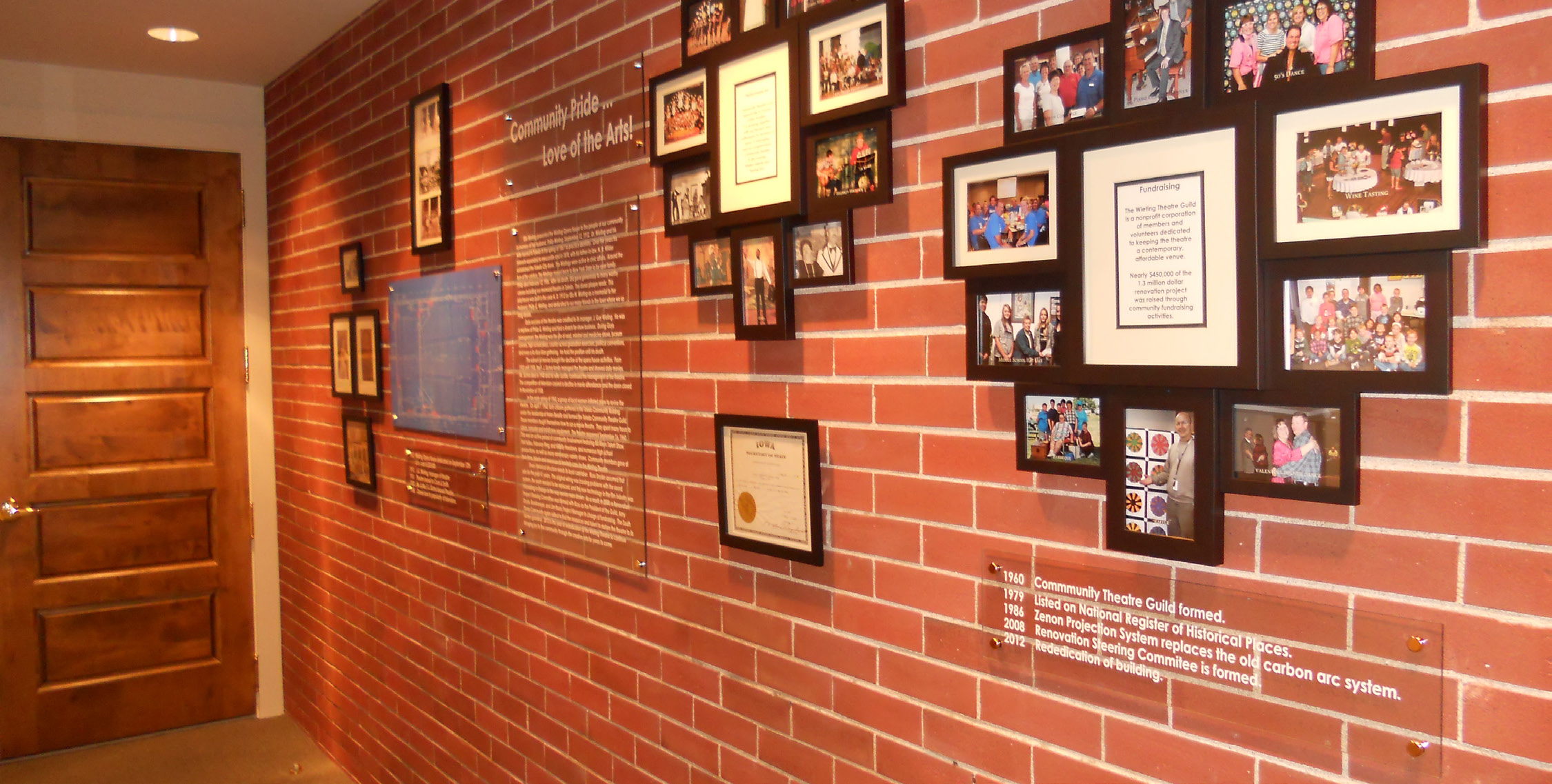
A wall in the Wieting’s basement is devoted to the theatre’s History. Photo courtesy of Abigail Evans
I am not unique in my fond experiences of the theatre. One recent grad from South Tama, Sadie Kavalier, speaks of it with reverence.
“In my personal life the Wieting has always been a major force in my family,” she says. “The environment [there] is unheard of for other communities of our size. When I was a kid, I would often go with my family to watch movies there. Throughout my childhood, I performed there for dance, and later for speech and talent shows.”
Kavalier believes that part of the charm of the theatre are volunteers who always greet guests with a smile on their faces. “Many of the volunteers are people I knew from church or others who were active in the community. It’s great to see familiar faces and know that those people are there because they want the Wieting to continue to be a part of the community.”
Through past and upcoming renovations, the Wieting will always to be a place to gather, to perform, to laugh and cry, or to sit back and watch a movie. Most importantly, it will continue to serve as a space to bring the local community together and to take a few moments to enjoy the beauty of the theatre and the company of one another.
With the upcoming renovations, the theatre will continue to have an impact on the lives of students and community members. When performers step on that stage, glowing under the new lights, they will feel the excitement that performers have felt for over one hundred years. When the lights go dark and the curtain closes, the audience will applaud passionately, for the theatre, for the performers, for the donors, and for the volunteers. The audience and performers alike will leave the theatre feeling that undeniable sense of community that the Wieting creates.

An architect’s rendering shows what the Wieting will look like when the new round of renovations is completed. Photo courtesy of Abigail Evans
